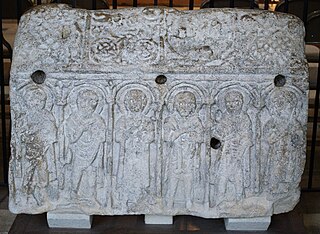Oswiu, also known as Oswy or Oswig, was King of Bernicia from 642 until his death. One of the sons of Æthelfrith of Bernicia, he became king following the death of his brother Oswald in 642. Unlike Oswald, Oswiu struggled to exert authority over Deira, the other constituent kingdom of medieval Northumbria, for much of his reign.

Æthelred was King of Mercia from 675 until 704. He was the son of Penda of Mercia and came to the throne in 675, when his brother, Wulfhere of Mercia, died. Within a year of his accession he invaded Kent, where his armies destroyed the city of Rochester. In 679 he defeated his brother-in-law, Ecgfrith of Northumbria, at the Battle of the Trent: the battle was a major setback for the Northumbrians, and effectively ended their military involvement in English affairs south of the Humber. It also permanently returned the kingdom of Lindsey to Mercia's possession. However, Æthelred was unable to re-establish his predecessors' domination of southern Britain.

Wulfhere or Wulfar was King of Mercia from 658 until 675 AD. He was the first Christian king of all of Mercia, though it is not known when or how he converted from Anglo-Saxon paganism. His accession marked the end of Oswiu of Northumbria's overlordship of southern England, and Wulfhere extended his influence over much of that region. His campaigns against the West Saxons led to Mercian control of much of the Thames valley. He conquered the Isle of Wight and the Meon valley and gave them to King Æthelwealh of the South Saxons. He also had influence in Surrey, Essex, and Kent. He married Eormenhild, the daughter of King Eorcenberht of Kent.

Peada, a son of Penda, was briefly King of southern Mercia after his father's death in November 655 until his own death in the spring of the next year.

The Battle of the Winwaed was fought on 15 November 655 between King Penda of Mercia and Oswiu of Bernicia, ending in the Mercians' defeat and Penda's death. The battle marked the effective demise of Anglo-Saxon paganism.
Cenwalh, also Cenwealh or Coenwalh, was King of Wessex from c. 642 to c. 645 and from c. 648 until his death, according to the Anglo-Saxon Chronicle, in c. 672.

Æthelwealh was the first historical king of Sussex. Æthelwealh became the first Christian king of Sussex and was king when Sussex was converted to Christianity in 681. In 661, Æthelwealh received the territories of the Meon Valley in modern-day Hampshire, and the Isle of Wight from his godfather, Wulfhere, king of Mercia. Æthelwealh was killed in around 685 by Cædwalla, at the time a prince of the Gewisse tribe of modern-day Oxfordshire, who had been operating as bandit in Sussex.

Cedd was an Anglo-Saxon monk and bishop from the Kingdom of Northumbria. He was an evangelist of the Middle Angles and East Saxons in England and a significant participant in the Synod of Whitby, a meeting which resolved important differences within the Church in England. He is venerated in Anglicanism, the Catholic Church and the Eastern Orthodox Church.
Alhfrith or Ealhfrith was King of Deira under his father Oswiu, King of Bernicia, from 655 until sometime after 664. Appointed by Oswiu as a subordinate ruler, Alhfrith apparently clashed with his father over religious policy, which came to a head at the Synod of Whitby in 664. After this, Alhfrith disappears from the historical record.
Æthelwold, also known as Æthelwald or Æþelwald, was a 7th-century king of East Anglia, the long-lived Anglo-Saxon kingdom which today includes the English counties of Norfolk and Suffolk. He was a member of the Wuffingas dynasty, which ruled East Anglia from their regio at Rendlesham. The two Anglo-Saxon cemeteries at Sutton Hoo, the monastery at Iken, the East Anglian see at Dommoc and the emerging port of Ipswich were all in the vicinity of Rendlesham.

The Middle Angles were an important ethnic or cultural group within the larger kingdom of Mercia in England in the Anglo-Saxon period.
Seaxwulf was the founding abbot of the Mercian monastery of Medeshamstede, and an early medieval bishop of Mercia. Very little is known of him beyond these details, drawn from sources such as Bede's Ecclesiastical History. Some further information was written down in the 12th century at Peterborough Abbey, as Medeshamstede was known by that time. This suggests that he began his career as a nobleman, and that he may have had royal connections outside Mercia.
Events from the 7th century in England.
The Christianisation of Anglo-Saxon England was a process spanning the 7th century. It was essentially the result of the Gregorian mission of 597, which was joined by the efforts of the Hiberno-Scottish mission from the 630s. From the 8th century, the Anglo-Saxon mission was, in turn, instrumental in the conversion of the population of the Frankish Empire.
Urbs Iudeu was a city besieged in 655AD by Penda, King of Mercia and Cadafael, King of Gwynedd. This was an important episode in a long-running war between Mercia and Northumbria in the years from 616 and 679.



















